ANTHROPOMETRY
Featured Engineering Publications
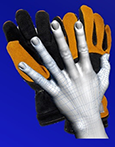
Firefighter hand anthropometry and structural glove sizing: a new perspective
Human Factors: July 2015 / [Epub ahead of print]
This study presented the most up-to-date firefighter hand anthropometry and evaluated the current use and fit of structural firefighting gloves. The results show that the current national standard structural firefighting glove sizing scheme underrepresents firefighter hand-size range and shape variation. An improved sizing scheme that better accommodates the U.S. firefighter population was proposed. The new system considered both hand size and hand/finger breadth-to-length contrast, which provided a new perspective for establishing improved hand models and national glove specifications to advance glove design.
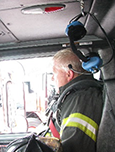
Seat and seatbelt accommodation in fire apparatus: Anthropometric aspects
Applied Ergonomics: May 2015 / 51(11):137-151
This study collected body dimension data on a representative sample of 951 U.S. firefighters, and applied the information to assess how well fire apparatus seat and seat belt designs accommodate current firefighters. The study found that today’s firefighters, on average, are much larger and have different body dimensions than data from previous generations that were used in the design of fire apparatus. Specifications for seatbelt length, seat width and spacing, and head supports were proposed for fire apparatus manufacturers and standards committees to improve firefighter seat designs and seatbelt usage compliance.
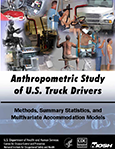
Anthropometric Study of U.S. Truck Drivers: Methods, Summary Statistics, and Multivariate Accommodation Models
NIOSH Publication No. 2015-116 (April 2015)
Since up-to-date anthropometric data, which plays an important role in improving ergonomic design of truck cabs, has not been collected for decades, NIOSH launched the first-ever federal anthropometric study of U.S. truck drivers. This document summarizes the results of the study that, we hope, will be used by truck manufacturers, parts suppliers, transportation researchers, fleet managers, and other interested parties for decades to come.
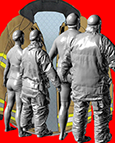
Comparison of Measured and Self-Reported Anthropometric Information among Firefighters: Implications and Applications
Ergonomics: December 2014 / 57(12):1886-1897
This study evaluated the accuracy of self-reported body weight and height compared to measured values among firefighters and identified factors associated with reporting error. The results showed that the self-reported approach is not a sustainable option for substituting for a professional anthropometric survey to lessen survey cost for protective equipment design applications. Self-reported anthropometric information is undependable in important population subgroups.
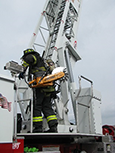
Sizing firefighters: method and implications
{NIOSH 2014 Bullard-Sherwood Transfer of Knowledge Award}
Human Factors: August 2014 / 56(5):873-910
This paper provided the first available U.S. national firefighter anthropometric information for fire apparatus design and presented a comprehensive data process method to assist data users in the business of firefighter safety and fire apparatus standards development to advance national standards on seat, seatbelt, structural firefighting gloves, fire truck cab, and protective clothing. View the Firefighter Datasets.

Research to improve extension ladder angular positioning and Extension Ladder Safety App (Android and iPhone
{2015 Federal Health Information Technology Innovation Award; NIOSH 2014 Alice Hamilton Engineering Award}
Applied Ergonomics: May 2013 / 44(3):496-502
The research provided scientific basis for the development and validation of a patented multimodal (visual, audio, and vibration) indicator to assist ladder users correctly set the inclination of angle of ladders to reduce ladder-slipping incidents; this invention was further developed to become a popular software application for mobile devices which features a multimodal indicator and a graphic-oriented guide for ladder selection, inspection, positioning, and safe use.
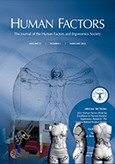
Anthropometric procedures for protective equipment sizing and design
{Human Factors and Ergonomics Society 2012 Human Factors Prize}
Human Factors: February 2013 / 55(1):6-35
This “science behind design” paper introduced a series of anthropometric theories and a 6-step process paradigm for quantifying human body shape and defining personal protective equipment fit and sizing schemes, which has become a most-read Human Factors Journal article, a critical reference for product design, and popular college course material in human factors engineering.
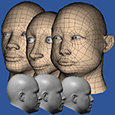
Head-and-face shape variations of U.S. civilian workers
Applied Ergonomics: February 2013 / 44(5):775-784
This study examined the head-and-face shape variation of the U.S. civilian workforce, using principle component analysis techniques. It also presented a computer graphics based intuitive visualization method for readers to visualize shape variation among civilian populations. The information on the range of head-and-face shape variation is critical for designing effective respirators and head protective gear.
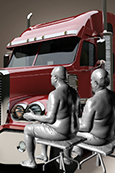
U.S. truck driver anthropometric study and multivariate anthropometric models for cab designs
{NIOSH 2011 Bullard-Sherwood Transfer of Knowledge Award}
Human Factors: October 2012 / 54(5):849-871
This paper presented the first comprehensive national truck driver anthropometry data for safer semi-trailer truck designs, which have been adopted by truck manufacturers, parts suppliers, and digital software developers to improve the design of next generation truck cabs and begin updating truck cab configuration industrial standards for improved driver health and public safety.
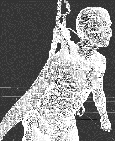
Impact of harness fit on suspension tolerance
Human Factors: June 2012 / 54(3):346-357
This paper provided scientific basis for standards writers, fall-arrest harness designers, and harness manufacturers to improve harness configurations and fit testing procedures for improved worker protection against suspension trauma (a fatal distress caused by reduced recirculation of blood from the legs to heart after a fall arrest) and recommended an incident response time window of 9 minutes in worker-fall rescue plans to alleviate suspension trauma.
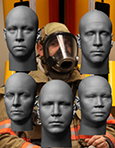
Digital 3-D headforms with facial features representative of the current US workforce
Ergonomics: May 2010 / 53(5):661-671
This study developed a new approach for constructing head forms that takes into account the facial form (size and shape) of the US workforce, based on an anthropometric survey of 3997 respirator users. It also presented five digital 3-D head forms to replace existing 30-year-old head forms. These new head forms are being incorporated into respirator research, certification standards, and design in efforts to reduce the risk of illness caused by inhalation hazards.
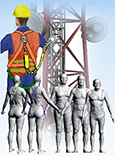
Development of sizing structure for fall arrest harness design
{NIOSH 2010 Alice Hamilton Human Studies Award}
Ergonomics: September 2009 / 52(9):1128-1143
This paper reports a series of 4 studies on worker-harness interfaces for fall-arrest-harness design and production to protect diverse worker populations, using the most current 3-D whole-body digital scanning technology and an innovative 3-D procedure to quantify human torso-shape effect on harness fit. The improved harness sizing system that accommodates diverse populations in the current workforce has been adopted by harness manufacturers to develop the next-generation harnesses.

Harness sizing and strap length configurations
{NIOSH 2010 Alice Hamilton Engineering Award}
Human Factors: August 2009 / 51(4):497-518
This paper described the development of fall-arrest harness sizing configurations to protect diverse worker populations and the determination of strap cut lengths and adjustment ranges of fall-arrest harness components for manufacturing purposes, using a national whole-body digital scan database and a computer graphics process technique, which have been adopted by leading harness manufacturers to develop the next-generation harnesses.
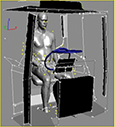
Anthropometric Criteria for the Design of Tractor Cabs and Protection Frames
{NIOSH 2006 Alice Hamilton Engineering Award}
Ergonomics: March 2005 / 48(4):323-353
This paper presented a revolutionary 3-dimensional whole-body scanning approach to study how human body shape and dimensions interact with farm tractor-cab layout to affect safe tractor operation, and provided representative digital human models for tractor manufacturers to assess their current tractor-cab accommodation and revise current tractor cab standards, which have had a positive impact on 6 million agriculture workers who operate farm machines.
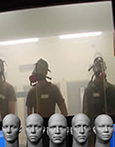
Evaluating the representativeness of the LANL respirator fit test panels for the current U.S. civilian workers
Journal of the International Society for Respiratory Protection: September 2004 / 21:83-93
This national head-and-face anthropometry study of respiratory users identified that the existing (as of 2004) full-face-piece respirator fit test panels, developed by the Los Alamos National Laboratory (LANL) in 1973, excluded the coverage of 15.3% of the U.S. civilian workers; the study led to a major revamp of respirator fit test panels and modifications of specifications of international standards on respirator fit test panels.
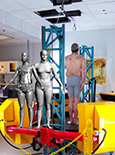
Sizing and Fit of Fall-Protection Harnesses
{2002 Liberty Mutual Prize, International Ergonomics Association}
Ergonomics: October 2003 / 46(12):1233-1258
This paper introduced a 3-dimensional full-body laser scanning concept to evaluate the fit and sizing efficacy of a fall-arrest harness system and presented a 15 representative body model method for testing existing harness designs, which laid the foundation for engineering anthropometry for personal protective equipment advancement.
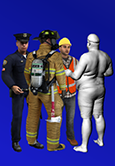
Anthropometric differences among occupational groups
Ergonomics: February 2002 / 45(2):136-152
This paper identified occupation as a critical factor (along with gender, age, and race/ethnicity) affecting population anthropometry and thus safety applications, which is a keystone paper that led to a series of national occupational anthropometry studies for improved safety controls and protection to occupational groups (e.g., firefighters, law enforcement officers, truck drivers, farm workers, and emergency medical service workers).
- Page last reviewed: April 12, 2017
- Page last updated: October 23, 2015
- Content source:
- National Institute for Occupational Safety and Health Division of Safety Research


 ShareCompartir
ShareCompartir